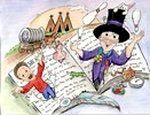Learn a Little Lit
 Olive Kitteridge got me thinking about point of view—who gets to tell the story. Elizabeth Strout’s book shifts from character to character, a narrative technique that lends her work its depth and beauty.
Olive Kitteridge got me thinking about point of view—who gets to tell the story. Elizabeth Strout’s book shifts from character to character, a narrative technique that lends her work its depth and beauty.
We see Olive, not only as she sees herself, but as she’s seen by the community. The pay-off is a richer, far more complicated portrait of Olive than if she alone—or any single narrator—had told us the story.
Point of view, or perspective, is one of the most important decisions an author has to make. Whoever tells the story shapes the story.
A little game: take a couple of novels, change the narrators…and see what happens. Try this as a book club activity. Here are some ideas to get started:
- Remains of the Day: what if Miss Kenton told the story rather than the butler Stevens? We’d miss the rich irony of a hopelessly naive narrator. In fact, if we weren’t inside Stevens’s head, he would seem a pitiless monster of a being.
- Gilead: if we were to see the story through shifty, unreliable Jack Boughton, the story’s prodigal son, we would never experience our own sense shame as we, along with Reverend Ames, willfully pass judgment on a misunderstood character.
More on point of view at a later date. In the meantime take our free LitCourse 8 on Point of View. It’s fun…quick…and informative.
 One of the joys of reading is the people we meet within a book’s covers, literary creations who jump off the page and into our lives. How authors do it—how they make their characters come alive for us—is one of the great mysteries of art.
One of the joys of reading is the people we meet within a book’s covers, literary creations who jump off the page and into our lives. How authors do it—how they make their characters come alive for us—is one of the great mysteries of art.
Authors invariably say their characters take on lives of their own. Here’s Stephen L. Carter (The Emperor of Ocean Park):
I was occasionally surprised by the messes my characters got themselves into, and the indignant, presumptuous way they demanded that I write a way for them to escape. Random House interview
And here’s Philip Roth with NPR Fresh Air’s Terry Gross:
Some magic, some alchemy between knowing and intuiting takes over and our characters take on lives of their own. First time this happened to me I felt like a real writer…. Julia Cameron nailed it when she wrote, “It’s not about making things up but taking them down.”
Even playwright Edward Albee (Who’s Afraid of Virginia Woolf) when asked whether his characters control him suggested they were somehow alive:
I like to let them think they do. It’s a trick we play on ourselves. They don’t exist, and they can’t say anything unless we write it for them. But it makes them happy to think they’re independent. Boston Phoenix
All this isn’t to say that writers don’t have to think, and think hard, about their characters. I’d like to continue a discussion of character—what goes into making a good one—in another post. Stay tuned.
Ideas for Book Clubs
- Take our free LitCourse 5—about characterization, how we talk about them and how author's develop them. It’s short and fun...and informative.
- Talk about some of your favorite characters in literature. Or some of literature’s most enduring characters.
 It’s said we live in an age of irony—irony is in; sincerity is out. It’s the importance of NOT being earnest that matters.
It’s said we live in an age of irony—irony is in; sincerity is out. It’s the importance of NOT being earnest that matters.
What is irony? Think Seinfeld—”Whatever…,” “Duh…,” “Yeah, riiiight”—all said with an arched eyebrow, a knowing wink. The “ironic stance” is detachment.
When it comes to fiction, writers, critics, and readers adore irony—most recently, Jonathan Franzen’s Corrections, Gary Shteyngart’s Absurdistan, Zadie Smith’s On Beauty, and Helen Fielding’s Bridget Jones. Even classics like Pride and Prejudice are plumbed for their irony.
Jane Austen’s brand of irony derives from her subversive wit, which undercuts class structure and decorum. It’s a type of irony in vogue today: one that exposes hypocrisy and punctures holes in pretensions, beliefs and institutions that no longer stand for truth or meaning.
But literary irony is far more complex. It’s been around since Oedipus—he who unwittingly marries his mother; who searches for a king’s murderer, only to find himself; and who attains inner “sight” only when blind.
Writers from Sophoclese on down have used irony because it mimics life. Though irony takes numerous forms, the most common definition is an opposite reality from what is intended or expected: the king brought low; the underdog raised up; best-laid plans gone awry.
To learn more about irony, see LitCourse 8—based on Edith Wharton’s wonderful short story “Roman Fever.” The courses are short, free, and fun! (And that’s not ironic.)
 When is a rose not a rose? When it’s a symbol. Do authors create literary symbols on purpose? Or are symbols just something English teachers invent to torment students. Could be . . . but here’s a little story.
When is a rose not a rose? When it’s a symbol. Do authors create literary symbols on purpose? Or are symbols just something English teachers invent to torment students. Could be . . . but here’s a little story.
—A Little Story—
I once wrote a poem for my English class about the beauty of a single rose. Understand when I tell you it was insipid.
But the teacher singled it out! It was, she said, a fine example of symbolism: the beauty of the single rose was how she viewed her students. In the collective we had little distinction, but individually we attained a singular beauty. Friends, I’d written a masterpiece . . . and I hadn’t a clue.
My grand inspiration had come from a cheap plastic rose stuck in my pencil holder, and I just happened to hit on the thing as my eye wandered around the room. The beauty of individualism wasn’t anywhere on the radar.
Yet that's exactly what author William J. Kennedy (Ironweed, 1983) was getting at when he wrote in a New York Times piece that the source of a writer's creativity doesn't . . .
rise up from his notepad but up from the deepest part of his unconscious, which knows everything everywhere and always: that secret archive stored in the soul at birth, enhanced by every moment of life….
—William Kennedy, “Why It Took So Long,”
New York Times, 5/20/1990
Writing is a mysterious process, and symbols often spring from the unconscious, relfecting something embedded within an author’s psyche.
In other words, that single rose of mine could just as easily have seemed lonely and forlorn. Or I might have written that its fragrance would gain potency as part of a bouquet. But it turns out I enjoy being alone or with friends one-on-one. And I avoid large groups. So perhaps even as a teen that rose had subconscious resonance.
So, no, authors don’t always intend their symbols; symbols often reflect something deep within. And readers? Our own insights into a work spring up from deep within us, as well.
If you want to learn more about symbolism—why authors use them, how they contribute to a work of fiction—take our LitCourse 9. It’s short, free, and a lot of fun.
Site by BOOM
![]()
LitLovers © 2024
